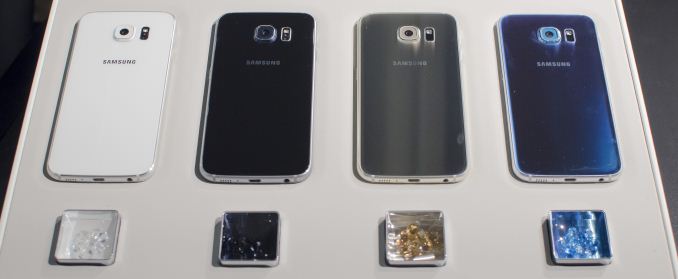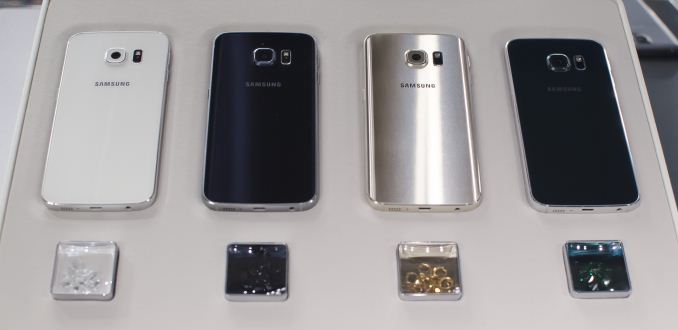Samsung Galaxy S 6 and S 6 Edge: Preview
by Joshua Ho on March 26, 2015 9:00 AM EST- Posted in
- Smartphones
- Samsung
- Mobile
- Galaxy S6
- Galaxy S6 Edge
Initial Thoughts
With the Galaxy S6 and S6 edge Samsung claimed that they wanted to completely rethink how they designed and made smartphones. On the surface, it seems that Samsung has delivered on this promise as the Galaxy S6 and S6 edge are unlikely any other Galaxy S phone they have made previously. There is no removable battery, no microSD slot, or even a removable back cover. I would’ve liked to see a microSD slot, but I personally wouldn’t be affected by being limited to 32GB of internal storage. The removable battery issue is a bit concerning for me though, as it’s likely that disassembling this phone to replace the battery will require extensive use of a heat gun to loosen glue that may not adhere properly when reassembled. The materials are now aluminum and glass, which dramatically affect in-hand feel. I definitely like the move to the aluminum and glass design for the improved look and feel of the phone, but the use of the glass back is a bit annoying as the phones have a tendency to slide off pretty much any table. The edge variant of the phone also feels quite sharp in the hand and almost too thin to hold, but this is generally quite subjective.
Outside of design, there is a lot to talk about in the SoC and display. The Exynos 7420 SoC appears to be class-leading in performance, although there is the obvious question of power consumption that still has to be answered. Samsung’s first 14LPE SoC seems promising, although we’ve yet to validate whether big.LITTLE is more efficient than when we last tested it in the Exynos 5433. The GPU is generally quite close to the Adreno 430, with about a 10-20% advantage in performance depending upon the workload, although at the same clock speed it probably wouldn’t have any advantage. The 1440p display can also reduce performance compared to a 1080p display.
Speaking of displays, Samsung has integrated an incredible display into both versions of the Galaxy S6. I’m really blown away at how far AMOLED has come in the past few years, as the Galaxy S6 is one of the best displays we’ve tested for luminance and overall color accuracy. The only real problems I can see are color shifts with viewing angles, and white point tending to be a bit green depending upon the unit we’re looking at. There are some edge-specific issues, namely uneven luminance and odd color shifting towards green hues on white at the edge of the display. Other than this, the display of the Galaxy S6 is relatively perfect with its dark, inky blacks and amazing color.
Obviously an SoC and display aren’t the only issues to discuss in a smartphone, but given the limited time that we’ve had with the device this was all that could be tested. We hope to have our full review for both devices completed in the near future, and to be able to provide the full picture of the Galaxy S6 line at that time. Pre-orders for the US Galaxy S6 variants will begin on March 27th, and the phone will go on sale on April 10th throughout the US with 32, 64, and 128 GB SKUs in Black Sapphire, White Pearl, and Gold Platinum. The S6 edge and S6 will be available on AT&T, Sprint, T-Mobile, Verizon, and US Cellular, but on Boost Mobile, Cricket Wireless, and MetroPCS only the S6 will be available.













200 Comments
View All Comments
Refuge - Thursday, March 26, 2015 - link
No, like comparing apples, and bigger apples.mkozakewich - Thursday, March 26, 2015 - link
But those apples are bigger! You can't compare them, because they're more like oranges now....I wonder what the differences are between apples, big apples, and oranges.
SunnyNW - Thursday, March 26, 2015 - link
Is the Exynos 7420 fully 64-bit enabled unlike the 5433?Andrei Frumusanu - Thursday, March 26, 2015 - link
Yes.phoenix_rizzen - Thursday, March 26, 2015 - link
Read the specs table. It lists it as shipping with the 64-bit version of Android 5.0 installed.lilmoe - Thursday, March 26, 2015 - link
I've had this on my mind for quite a while, but ever since the Snapdragon throttling fiasco, I've took further notice in throttling and its effects on usability and benchmarks of smartphones, and lots of past thoughts have become clearer to me.In that regard, I believe some cross-platform benchmarks are worth investigating since some (geekbench particularly) do NOT have the same running times for each platform. When the A7 was released with better single thread performance, I thought the running time of Geekbench on iOS was too short compared with that on Android, but I sort-of dismissed that thinking that maybe the benchmark was stressing AES and other ARMv8 enhanced instructions more than others, thus finishing faster since they were much faster on ARMv8. But when Android was getting powered by ARMv8 processors AND scoring higher than the A8, things have become alarming to me.
Thus my conclusion; Geekbench, among other benchmarks, are NOT calculating their scores fairly across platforms. For iOS in particular, the running time of the benchmark is noticeably shorter thus not stressing the SoC enough for thermal throttling to kick in. I'm therefor debunking ALL cross-platform benchmarks as not being consistent/reliable for cross platform measure of performance.
It would really be helpful if Anandtech spare some time in either proving or disproving this theory, just like they did with the benchmark "cheating" fiasco. Also, it would also be wise to fully throw Chrome out of the picture and ONLY use the stock browser (if present) and not only give that piece of info a mention deep in the article if you're going to insist on using a "Browser benchmark" for testing cross-platform CPU performance (which shouldn't be the case in the first place).
Thanks.
Andrei Frumusanu - Thursday, March 26, 2015 - link
You're demanding that benchmarks use fixed run-time instead of fixed workload. Fixed workload is still a much better representation of performance.MrCommunistGen - Thursday, March 26, 2015 - link
I think what lilmoe is trying to say is that based on his observations, benchmarks like Geekbench might *not* be using the same fixed workloads across platforms.Disclaimer: I'm not supporting either side of the argument, just attempting to clarify.
lilmoe - Thursday, March 26, 2015 - link
+1If they were running the same workload, how can a device score higher and finish the test much later... Every passively cooled performance processor throttles under constant stress conditions, and the difference in performance is significant.
MrCommunistGen - Thursday, March 26, 2015 - link
I think they're using Chrome so that all Android devices are tested on an even footing (the same browser). It may not be well optimized, especially on newer platforms, but at least the devices are using the same rendering engine, etc. I'm sure there's tons of arguments here, but that's my 10-second thought process.Also, I'm not sure if I'm alone in this, but I ditched the stock browser years ago during the Gingerbread days when I actually started heavily using my devices. I worked at a cellphone store at the time and switched phones often. The inconsistency between stock browsers (speed, page rendering, and UX differences) caused me to pick a common browser across devices - I think at the time I was mostly using Dolphin.
These days, for better or worse, I almost exclusively use Chrome - Some of that might be because my last device was a Nexus 5. I'll hop over to Firefox if something renders strangely in Chrome or sometimes just to see how the browser is doing, but I don't think I've ever launched the "Internet" app on my Note 4 (Snapdragon).